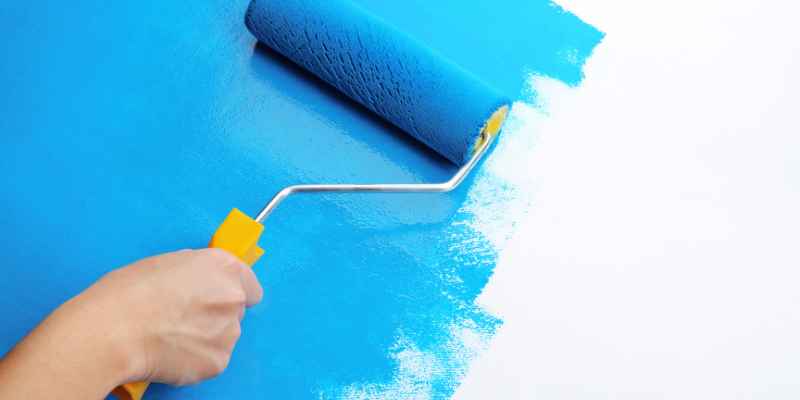Paint usually dries slightly darker than its wet color. When the paint dries, it undergoes a chemical reaction that results in a small darkening effect.
One common question that people have when painting walls or furniture is whether the paint will dry darker or lighter than its initial color. Understanding how paint dries is important for achieving the desired end result. Generally, when paint dries, it tends to darken slightly compared to its wet color.
This occurs due to a chemical reaction that takes place as the paint dries. While the difference in shade may not be significant, it is essential to take this into account when choosing a paint color, particularly for large surfaces where the cumulative darkening effect might be more noticeable. By being aware of this darkening process, you can make informed decisions to achieve the desired color outcome.
Does Paint Dry Darker Or Lighter?
Paint can dry either darker or lighter depending on various factors, including the color, type of paint, and the surface it’s applied to. It’s essential to consider these factors when choosing and applying paint to achieve the desired shade.
Factors That Affect The Color Of Dried Paint
When it comes to painting, getting the color just right is essential. You carefully choose the perfect shade for your project, but have you ever wondered if paint dries darker or lighter than it initially appears? Let’s dive into the science behind it.
Understanding The Role Of Pigments
One of the key factors that influence how paint dries is the presence of pigments. Pigments are responsible for giving paint its color. They are finely ground particles that are added to the paint mixture, and they can vary significantly depending on the type of paint you are using.
For example, in acrylic and oil-based paints, pigments are suspended in a binder that dries into a solid film. As the paint dries, the binder forms a transparent layer that coats the pigments, affecting how light interacts with the color.
In water-based paints like latex and watercolors, pigments are dispersed in a water-soluble medium. As the water evaporates, the pigments consolidate and form a thin film, showcasing the color more accurately.
Factors That Affect The Color Of Dried Paint:
- Opacity of the pigment
- Thickness of the paint layer
- Drying time and conditions
- Surface texture
The opacity of a pigment plays a significant role in how the paint dries. Some pigments are more transparent, allowing light to pass through the layer and interact with the underlying surface. This can result in a paint that appears lighter when dry.
On the other hand, more opaque pigments block the light, causing the paint to appear darker when it dries. The thickness of the paint layer also affects the final color. Thicker layers can result in darker shades, while thinner layers may appear lighter.
In addition to pigments and thickness, drying time and conditions can influence the color of dried paint. Factors such as humidity, temperature, and airflow can impact the drying process, potentially altering the final color. Similarly, the texture of the surface being painted can affect how light reflects off the dried paint, resulting in variations in color perception.
In conclusion, while it is difficult to predict exactly whether paint will dry darker or lighter, understanding the role of pigments and considering various factors can give you a better idea of how your paint will ultimately look. By taking these factors into account, you can make more informed decisions when choosing and applying paint for your projects.

The Surprising Truth
Discover the surprising truth about whether paint dries darker or lighter. Uncover the secrets behind the optical illusion that can have a significant impact on your home decor choices.
Why Paint Can Appear Darker When Dried
Many people have had the experience of painting a wall or an object only to notice that the color appears different when it dries. It can be frustrating and confusing, but there is actually a scientific explanation behind this phenomenon. The truth is, paint can indeed appear darker when it dries, and it all has to do with the way light interacts with the pigments in the paint.
When paint is wet, it tends to have a higher sheen and reflects more light, which can make the color appear lighter than it actually is. As the paint dries, the sheen begins to fade, and the pigments become more concentrated. This concentrated pigmentation is what gives the paint its true color and can make it appear darker than when it was wet.
Another factor that contributes to the paint drying darker is the evaporation of the solvents in the paint. These solvents are responsible for keeping the paint in a liquid state and allow for easy application. However, as they evaporate, they leave behind the pigments which are more concentrated and can make the color appear darker.
How Lighting Conditions Impact Perception Of Color
Not only does the drying process affect the appearance of paint, but the lighting conditions in the room can also have a significant impact on how we perceive color. Lighting plays a crucial role in how we see colors, as different light sources can emit different wavelengths of light.
For example, natural daylight is considered the most accurate representation of color as it contains a full spectrum of light. However, artificial lighting, such as incandescent or fluorescent bulbs, may emit light in specific wavelengths that can alter the way we see color. This means that a paint color that appears one way in natural daylight may look completely different under artificial lighting.
Apart from the type of light source, the direction and intensity of the light can also affect color perception. Shadows, reflections, and even the color of surrounding objects can influence how we see the color of dried paint. It is important to consider these factors when selecting a paint color and evaluating how it will look in different lighting conditions.
Tips For Accurate Color Selection
Choosing the right paint color for your walls can significantly impact the overall look and feel of a room. However, many people are unsure of how the paint will dry and whether it will appear darker or lighter than the sample swatch. If you want to avoid any surprises and achieve the desired results, these tips will help you select the perfect paint color.
Using Swatches And Testers
Before committing to a paint color, it’s essential to test it out first. Realizing that paint can dry differently than it appears when wet, relying solely on color swatches may lead to disappointment. Instead, always opt for testers. These smaller samples allow you to see how the paint will dry on your walls, giving you a much more accurate representation of the final color.
When using testers, it’s important to apply them on the same surface that you plan to paint. Paint a few different sections of the wall, as natural or artificial lighting can affect how the color appears. Pay attention to the drying time, as some paint may darken or lighten as it dries. This will allow you to make an informed decision about which shade will work best in your space.
Considering The Sheen Of The Paint Finish
The sheen or finish of the paint can also influence its final appearance. Different sheen levels, such as matte, eggshell, satin, semi-gloss, or high-gloss, can reflect light differently, resulting in variations in color perception.
Keep in mind that paint with a higher sheen level usually appears slightly darker when dry. So, if you want the color to appear true to the sample, opt for a lower sheen finish. On the other hand, if you prefer a more intense or dramatic look, a higher sheen may be exactly what you’re looking for.
It’s advisable to consult the paint manufacturer’s guidelines to understand how the chosen sheen will affect the color when it dries. By doing so, you can make an informed decision and achieve the desired color outcome for your room.
Common Misconceptions
Paint drying does not typically change the shade. Misconceptions suggest paint dries darker or lighter, but it actually dries to its true color.
The Myth Of Paint Drying Lighter
One of the most prevalent misconceptions when it comes to paint drying is that it will always dry lighter than its initial color. However, this is not necessarily true. While it may seem logical to assume that the paint will appear lighter once it dries, the reality is that paint can dry darker, lighter, or even the same as its wet state. The confusion stems from various factors, including the characteristics of the paint itself and the conditions in which it dries. It is important to debunk this common myth and gain a better understanding of how paint truly behaves during the drying process.
The Influence Of Base Colors On Dried Paint
Another misconception that arises is the belief that the base color on which the paint is applied will significantly affect the dried paint’s darkness or lightness. While it is true that the base color can have a subtle influence on the appearance of the dried paint, it is not the primary determining factor. The base color acts as a background for the paint but does not drastically alter its shade.
Paint drying darker or lighter than expected can be attributed to several factors, including the type of paint used, the thickness of the paint layer, and the environmental conditions during drying. It is essential to consider these variables when gauging how paint will dry.
To gain a better understanding of the drying process
It can be helpful to consider the specific characteristics of the paint being used. Different types of paint, such as oil-based or water-based, have varying drying behaviors. Some paints, like oil-based ones, tend to darken as they dry due to the chemical reactions occurring within the paint’s composition. On the other hand, water-based paints often dry lighter as the water evaporates, leaving behind the pigments that contribute to the paint’s color.
Additionally, the thickness of the paint layer can influence how it dries. Thicker layers of paint may take longer to dry and can result in a deeper, richer color. Conversely, thin layers may dry quicker and appear lighter in comparison.
The environmental conditions during drying also play a crucial role. Factors such as temperature, humidity, and ventilation can affect how paint dries. Higher temperatures and lower humidity levels can speed up the drying process, potentially leading to a darker appearance. Conversely, lower temperatures and higher humidity levels may slow down drying and result in a lighter finish.
In conclusion, the notion that paint always dries lighter is a misconception. Paint drying can vary widely depending on the type of paint, thickness of the layer, and environmental conditions. Understanding these variables will help to set realistic expectations and achieve the desired results when it comes to dried paint color.

Expert Recommendations
If you’ve ever embarked on a painting project, you know that the color you choose isn’t always the exact shade that ends up on your walls. The question of whether paint dries darker or lighter is a common concern among homeowners. To help you get a precise color result, here are some expert recommendations that you should consider before picking up that paintbrush.
Preventing color discrepancies when the paint dries is essential to achieve your desired outcome. Here are some effective strategies to help you maintain color integrity during the drying process:
- Carefully choose the paint finish: Different paint finishes can impact the final look of the color. Matte and flat finishes tend to make colors appear darker, while glossy finishes can make colors appear lighter. Consider your desired effect and choose the appropriate finish accordingly.
- Test the color on a small area: Before committing to an entire room, it’s always a good idea to test the paint color on a small area of your wall. This allows you to see how the color will dry and make any necessary adjustments beforehand.
- Use primer: Applying a primer before painting can help create a smooth and consistent surface, enhancing the color’s true tone.
- Consider lighting conditions: Lighting plays a significant role in how color is perceived. Take into account the natural and artificial lighting in your space to ensure your chosen color appears as you intend.
- Apply multiple coats if needed: Sometimes, a single coat of paint may not achieve the desired depth or intensity. Applying additional coats can help achieve a truer representation of the color.
When it comes to color matching, consulting professionals can provide invaluable expertise and ensure your paint color matches perfectly. Here are some reasons why seeking professional help is beneficial:
- Years of experience: Professional painters and color consultants have years of experience in working with different paint brands and colors. They have a keen eye for detecting color disparities and can offer expert advice on color matching.
- Specialized color tools: Professionals have access to specialized color-matching tools such as colorimeters and spectrophotometers. These devices can analyze the color composition of the existing paint and create an accurate match.
- Customized color formulas: If you have a specific shade in mind, professionals can create custom color formulas to match your vision precisely.
- Save time and effort: By consulting professionals, you can save time and effort in the trial-and-error process of color matching. They can help you avoid costly mistakes and ensure you achieve the desired result right from the start.
By following these expert recommendations, you can minimize color discrepancies and maximize the chances of achieving the perfect paint color. Whether you decide to take preventive measures or seek professional assistance, remember that understanding the nuances of paint drying will lead to a more satisfactory painting experience.
Conclusion
The drying process of paint can often lead to a slight darkening or lightening of its color. While there are various factors such as the type of paint, lighting conditions, and drying time that can influence the final shade, it is generally observed that water-based paints tend to dry lighter while oil-based paints can dry darker.
By understanding these factors and properly planning your painting project, you can achieve the desired color outcome for your space.


